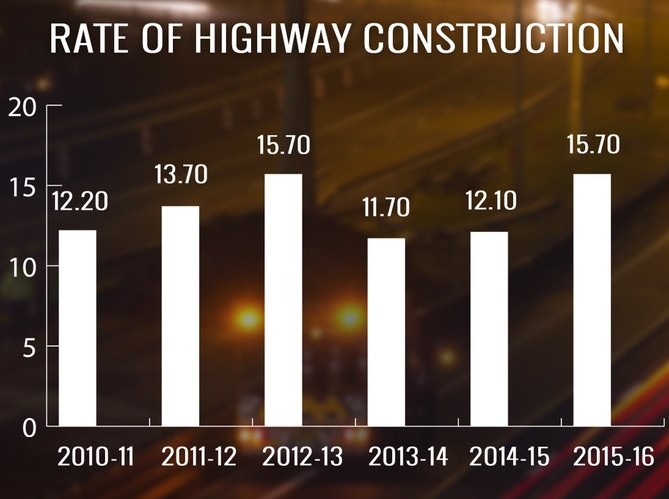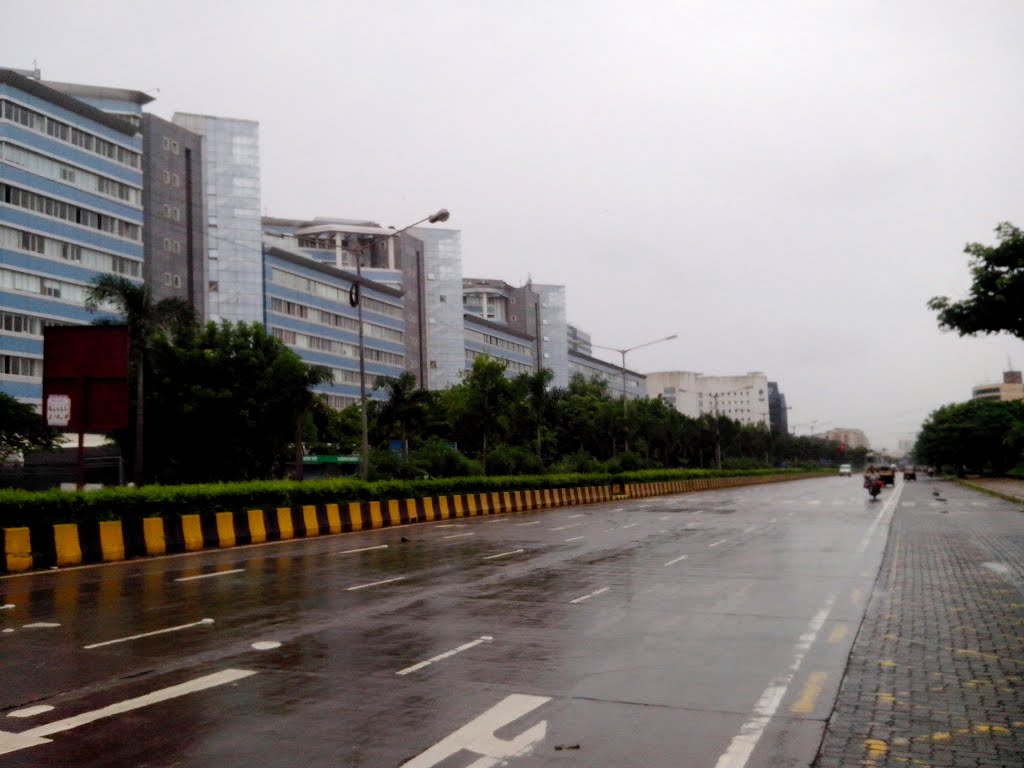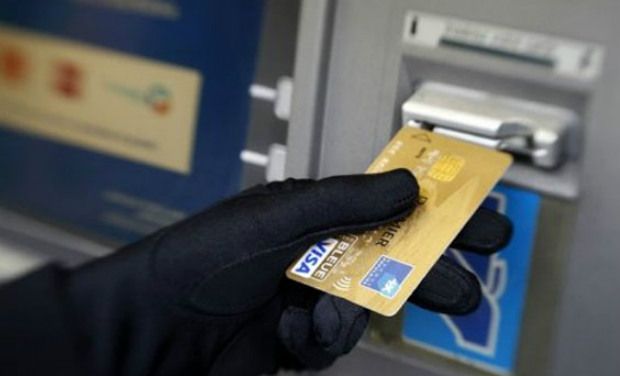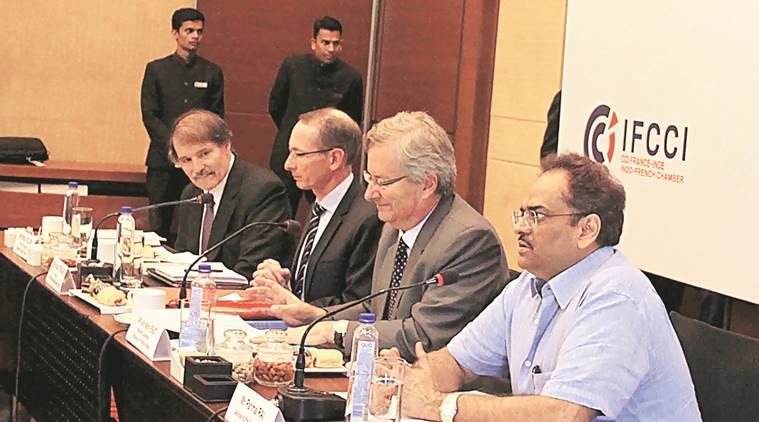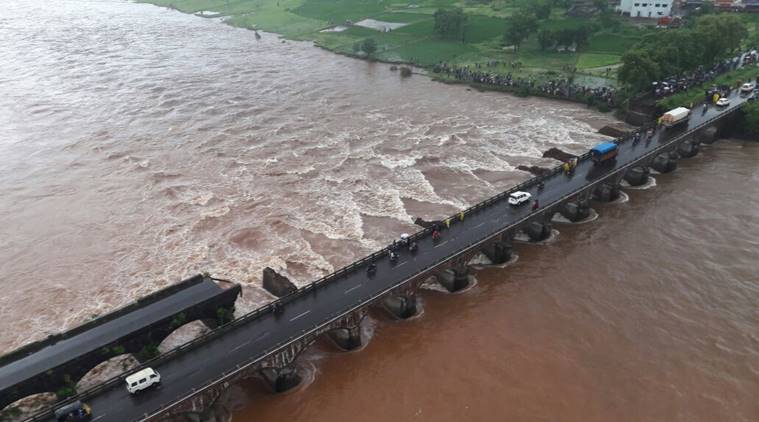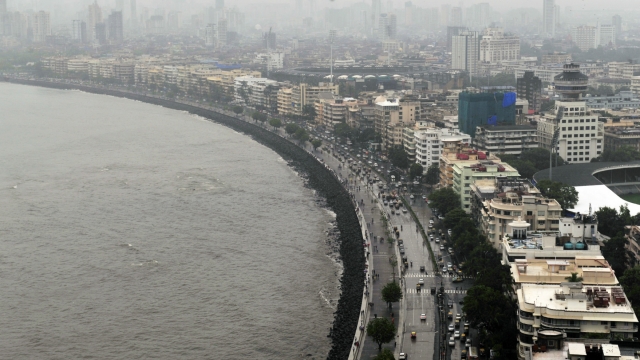An analysis by CRISIL on the pace of road construction
October 26, 2016
Annual highway construction
Year Distance
2011-12 2207 km
2012-13 2481 km
2013-14 1628 km
2014-15 1576 km
2015-16 2196 km
2016-17P 3040 km
2017-18P 4242 km
Pace of execution improves
8 months post awarding 12 months post awarding 18 months 30 months
2012-13 2% 3% 3% 41%
2013-14 9% 18% 39%
2014-15 5% 24%
Road projects : Full speed ahead
The speed of execution of projects awarded by the National Highways Authority of India (NHAI) improved 40% from an average 4.3 km per day in fiscal 2015 to 6 km in fiscal 2016. The material improvement in the pace of execution can be attributed to policy reforms by NHAI and facilitations by the government which are also reducing delays. The pace of execution is now expected to nearly double to over 11 km by fiscal 2018, propelled partly by execution of engineering, procurement, construction (EPC) projects awarded in the past three fiscals, according to research firm CRISIL.
However, even in the case of build, operate, transfer (BOT) and stuck projects, there has been some positive movement. For example, 15 NHAI projects were completed in the first four months of the current fiscal of which seven were BOT toll projects and four were awarded prior to 2009. CRISIL also analysed disaggregated data on execution for all projects awarded by NHAI during fiscals 2013, 2014 and 2015 at eight, 12, 18, and 30 months after awarding. Here too, the prognosis is encouraging with close to 25% execution taking place 12 months after projects were awarded in fiscal 2015.
The pace of execution of BOT projects awarded in fiscal 2013 has also ramped up to around 40%, 30 months since.
The key policy reforms initiated include easing of the clearances process, ensuring 80% land acquisition before the award of project, premium rescheduling, allowing developers to fully exit operational road projects, and introduction of the hybrid annuity model. Given that these reforms are largely aimed at reducing risk, CRISIL believes that private participation is set to pick up. Nonetheless, while the situation appears to be improving, there are still several BOT projects awarded between fiscals 2010 and 2012 that continue to be delayed, and are consequently viewed as high-risk projects.
Mumbai University gives way for better connectivity at BKC
October 26, 2016
The University of Mumbai has decided to hand over 34,715 sq. meters of land to Mumbai Metropolitan Regional Development Authority (MMRDA) which will be used for de-congesting the area around the important business district of the city – the Bandra Kurla Complex (BKC). MMRDA will be constructing a 1.2-km long elevated road with 2+2 lanes from Bharat Diamond Bourse Junction in BKC to Vakola Junction near Western Express Highway (WEH). For the purpose, Mumbai University will hand over a land measuring18,834 sq. meters to MMRDA.
MMRDA will construct a 400-m long and 30-m wide road in the vicinity of Mumbai University for additional connectivity from BKC to Santa Cruz Link Road (SCLR). For the purpose, Mumbai University will hand over a piece of land measuring 15,881 sq. meters to MMRDA.
The transfer and development (TDR), generated after handing over of the land to MMRDA, will be sold and used for the overall development of Mumbai University which will include construction of hostels, staff quarters, guest houses, science block, etc. in an area of 3 lakh sq. meters approximately.
A joint statement was issued by UPS Madan, Metropolitan Commissioner, MMRDA and Sanjay Deshmukh, Vice Chancellor, Mumbai University on the issue. The statement said, MMRDA, in its pursuit to provide better connectivity to ever developing BKC, is constructing a few flyovers such as the one from Bandra-Worli Sea Link to BKC, which is aimed at providing signal-free traffic from the Sea Link (from the Mahim Causeway side) all the way up to BKC, and a similar one from BKC to Sea Link.
“In addition, there will be a road on stilts from Kalanagar towards Sea Link, which will cater to the traffic from Sion/Dharavi,” the statement said. The estimated cost of the work will be Rs 253 crore.
Debit card scare: A lesson for banks and their customers
October 24, 2016
One of the biggest cases of suspected debit card data, that was compromised, highlights the importance of a key issue in the financial sector – customer education. The importance of customer education is becoming increasingly indispensable in this financial environment characterised by cutting-edge technologies and product and process innovation. While there are occasional reports of fraud in automated teller machines (ATM) that make it to the brief columns in newspapers, the recent case made headlines as the magnitude of the scare was significantly larger.
Data is suspected to be compromised of around 32.5 million debit cards which were used for transactions in 90 odd ATMs of a particular bank located across the country. According to the National Payments Corporation of India (NCPI), the home-grown payments gateway – the problem came to light after the receipt of complaints from a few banks that their customers’ cards were used fraudulently, mainly in China and USA while the customers themselves were in India. Apprehending that this could be a case of card data compromise, all the ATMs/PoS terminals in India and three card networks – RuPay, Visa and MasterCard worked in a collaborative manner in the month of September 2016.
It was found that the complaints of this fraudulent withdrawal were limited to cards of 19 banks and 641 customers. The total amount involved is Rs 1.3 crore as reported by various affected banks to the NPCI. The fact that the number of complaints were limited is mainly due to the fact that about 50 per cent of the banks’ customers do not have their account numbers linked to their mobile phone numbers. As a result, they did not receive any alerts when a transaction was made. Furthermore, when banks did start alerting them to change their pin, this communication was also not received by them. As a result, some banks like State Bank of India decided to block the cards and issue new cards, which is of course an added cost to them.
This is despite the Reserve Bank of India (RBI) issuing a circular about two years back asking banks and customers to get their mobile numbers registered and that the banks should alert their customers for every transaction. Moreover, even if the customers’ mobile number is registered with the bank, sometimes the bank only sends alerts if the value of the transaction is more than a particular threshold, say Rs 1,000 or Rs 10,000. This varies from bank to bank. This is against the spirit of the RBI guidelines. RBI norms clearly say that if a bank wishes to, it can charge the customers for the SMS alert service. However, some banks are not charging but at the same time, not sending SMS alerts for each and every transaction.
What is a Smart City ?
October 20, 2016
Deepak Premnarayen, President, Indian Merchants Chamber, Chairman FirstRand Bank India/ Non-Executive Director, FirstRand Global Board South Africa, expands on his idea of smart cities for India.
Excerpts from an interview :
Chandigarh, Nagpur and Pondicherry have been chosen by the French for adoption as they want to focus on these cities in India to develop them into smart cities. What do you think are the attractiveness of these cities? Would you say they are relatively better placed in terms of their infrastructure as compared to other cities in India?
Cities are chosen based on the survey and contest which included parameters like extent of citizens’ engagement and participation, strategic planning for the city, vision and goals, amongst others.
Each of the above cities is unique. Chandigarh has a French connection as it was designed by Le Corbusier – a French architect who worked on a new city in 1960s. It was and is a model city in terms of layout, the scope of expansion to absorb growth, its strong regional economic base. Nagpur is another city, has tremendous scope and opportunities of expansion for domestic and industrial requirements. Pondicherry – being an ex- French colony and historical connections – also comes under the above charterstics to be developed as a smart city.
Cities, if they have to become smart, have to be compact structures which support innovation in public transportation, use of smart technologies to manage power, infrastructure, and public safety, recycle water and manage work places with quality of life being enjoyable.
China, which saw huge growth rates continuously over two decades, relied on making its cities smart to bear the burden of industrialisation and consequently of urbanisation, which is the key to growth
If India is to grow at impressive rates, there have to be a local model of development where there has to be a shift from agriculture to industrialisation, which has to be supported by new employment opportunities, rise in consumer demand, and related spending and adoption of new smart technologies to support smart cities.
The cities which have been chosen so far to be developed as smart cities, have a comparative advantage of being better placed with respect to civic amenities, high disposable incomes and opportunities for trade. Also, commerce and industrialisation opportunities are promising, all which are important points in favour of smart cities.
What is the definition of a smart city in the Indian context? Is there a particular model that India needs to look up to, like a French model or a model from any other part of the world?
Cities in India have to be planned as innovative industrial cities which create jobs, which raise the quality of living, which integrates cultural ethos and social fibre to make cities vibrant. In Indian context the smart city has three connotations:
- Green Field Smart City – where every initiative is taken afresh – right from planning, execution, technology, regulation and financing – all happening at a new level, with new ideas, and bringing new innovations.
- Redevelopment – where an old structure or set up in an existing geographical area or segment is built afresh. The most critical areas is undertaken for refurbishing. This model has limitation in terms of human resettlement and the extent of services that need to be redeveloped. In this the though innovative and modern contemporary technology is launched, the canvas is small.
- Retro fitment is a mechanism, where only a portion of the segment needs change. This is a piece meal type of a “smartness” being brought into a small segment of the city. The scope of introducing retro fitment – is vast and since it is less time consuming and working on limited budgets, many cities could be looking at this option.
India needs a fine combination of all the three “models “ depending on the extent and scope of demand for change. For example, seven new cities are planned along the Delhi Mumbai Industrial Corridor, as Smart cities. These could be developed on model of Green Field Smart City project, which offers an unlimited scope to implement new ideas in civic services – such as adoption of technology in managing novel transport arrangements, uninterrupted water supply, newer sanitation offerings, recycling of water and solid waste management, e governance, involving citizens engagements and ensuring their safety – amongst others. As many of the Indian cities are having historical lineages, redevelopment and retro fitment could also be the complementary solutions
What is it that is required to be done in India in order to achieve a standard of development and civic amenities that is so nicely done in the developed countries?
Innovative financing methods need to be looked at. As most of the corporations and municipalities have very limited resources of generating revenues themselves, they depend on the grant of state governments, which themselves are under heavy financial strain and deficits. This is a limiting factor for them to experiment with new technologies in civic administration and services as a contemporary with other sister cities across the global. Thus innovative ideas of PPP, venture capital financing, launching of municipal bonds or even Smart City Bonds could be considered.
Secondly the Municipal corporations have to be corporatized with a structure which is less bureaucratic and more performance oriented. The head of a Smart City can be a CEO brought in from the market with market driven experience in administering – both on managerial and technology capabilities.
Thirdly- Performance and Ranking Index could be developed for the Smart City / municipal corporations to attract investment, attract service providers and attract citizens to be part of this city. The rating criteria would be marked on the basis of in diverse parameters such a quality factor of air and water, employment opportunities, civic amenities, quality of infrastructure etc.
French firms take initiative to develop Smart Cities in India
October 20, 2016
With the Smart Cities mission well underway, get ready for a slice of Paris in India! Three cities – Chandigarh, Puducherry and Nagpur – have attracted interest from the French who have proposed to develop them fully into smart cities. Strong on aesthetics as well as energy conservation, the French model of development also focuses on the user at the center of all development.
French consul general to India Yves Perrin says, “My concept of smart cities is based on at least four pillars, namely, energy, transport, water and waste management. These basic things have to be implemented first. Only then can cities be made smart.” ‘Smartness’ is everything that is required to make you comfortable in your daily life, adds Perrin.
One of the French companies already very well-entrenched here is Egis India, the Indian arm of the French engineering major Egis Group. The company has won a contract to develop Bhubaneswar and has also bid for Chandigarh. Tenders for Puducherry and Nagpur are yet to be issued by the two town authorities. However, Egis has separately successfully bid for the Nagpur metro and is already working on the project. “We can provide a metro but if one needs to stand in long queues, this is not fully facilitating,” points out Ashish Tandon, MD, Egis India. “If we only facilitate your commute from one place to another, and that too not very comfortably, and with no last-mile connectivity, then what is the point? It should be such that you are able to very conveniently reach the metro station and also conveniently be able to go where you want when you get out at the other end. Therefore, we have planned bicycles and e-rickshaws for Bhubaneswar. We may even do a light rail transit (LRT). The focus is on inter-modal transport,” says Tandon. (LRT is a series of localised automated guide-way transit systems acting as feeder services to the heavy rail MRT (mass rapid transit)).
Egis has done a lot of work in Paris and the Greater Paris area and one can expect “a lot of commonality between the cities we have done in France and what we will do here,” says Tandon. He adds, “Moreover, we do predictive modeling since we are looking at planning ahead for the next 20 years.”
Another area of strength for France is the digital domain where the country emerged as one of the early spenders globally. “This is an area that comes naturally to them and therefore, you may find a very strong digital infrastructure in whichever city the French associate themselves with. In the areas of traffic automation, car scanners for parking, road safety technologies, etc., you may find very high-tech solutions. Information technology will be the backbone to collate all kinds of data to make life easier for citizens,” says Pratap Padode, Founder and MD, Smart Cities Council India.
He adds that over 30 countries have evinced interest to partner with India for the Smart Cities mission and are interested in picking up business in India. And since there is more than Rs 3 lakh crore that is going to be spent on the mission by the government, obviously, everybody would like to have a slice of this pie. One of the ways to garner a slice, is to finance the master plan for the cities, like France has proposed for Chandigarh, Puducherry and Nagpur and the US for Visakhapatnam. Specifications are then evolved for creating a smart city with inputs from world-class experts and consultants mostly from that country that also enable their own companies to bid for the bigger set of orders for execution and implementation, explains Padode. “It’s a win-win situation because for India, in a sense, we are getting our cities designed for 20-30 years into the future for free. And for France or for any other country, they are able to get business for their companies,” Padode adds.
Till date, two memorandums have been signed, one of them with the US Trade and Development Agency (USTDA) to develop Visakhapatnam, Allahabad and Ajmer, and the other with Agence Francaise de Developpement (AFD). The MoU with AFD is independent of the Smart Cities mission but not unrelated to it and a line of credit will be used to develop Nagpur, Chandigarh and Oulgaret (Puducherry).
Chandigarh already has a French connection, having been planned by noted French architect Le Corbusier. Puducherry has been a former French enclave. And in Nagpur, the French are also interested in the metro project as well as in upcoming industries in the vicinity.
Under the MoU for a period of three years, the technical cooperation programme will make available to Puducherry a pool of French experts from the public sector (French municipalities, local public companies, agencies for urban planning), complemented by experts from the private sector. The experts will be chosen from domains such as sustainable urban development, integrated development and urban planning, urban transport, water and waste management, architecture and heritage, renewable energy and energy efficiency.
“In a larger context, the pool of experts could rotate like a roster between the three Indian cities to which French technical assistance will be provided,” the agreement states. They would essentially focus on areas such as strengthening the strategy and management of urban services, covering integrated development and urban planning, urban transport, water supply, sanitation, waste management, architecture and heritage, renewable energy and energy efficiency.
French firms like Alstom, Dassault, Egis, Lumiplan, RATP Transdev and Schneider are interested in the Smart Cities Mission. High-profile visits have been ongoing for over a year to Puducherry, Nagpur and Chandigarh.
Savitri river bridge collapse gives way to IBMS
October 20, 2016
In August this year, a British-era bridge spanning the Savitri river on the Mumbai-Goa highway collapsed. The tragedy occurred in the dead of the night and over ten vehicles were washed away, killing more than 26 people while 30 people were swept away in the swollen river.
In a country where construction collapses are quite the norm, the government is now waking up to the possibility of using modern technology to ensure the safety of bridges and their timely maintenance. Recently, minister of road transport & highways and shipping Nitin Gadkari, launched the Indian Bridge Management System (IBMS) in New Delhi as a inevitable step.
“IBMS is preparing a database of all bridges in the country and detailing their structural condition so that timely action can be taken to repair the structures or build new ones in their place,” said Gadkari.
In early 2015, the government had roped in IDDC Engineers, an infrastructure development firm, to develop this system. Subsequently, a National Bridge Management Centre (NBMC) was also up in Noida within Indian Academy for Highway Engineers (IAHE). According to an official, so far 1,15,000 bridges have been inventorised, of which 85,000 are culverts and the rest are bridges.
According to a ministry official, during the process each bridge is assigned a unique identification number based on the state, RTO zone and whether it is situated on a national highway, state highway or on a district road. The precise location of the bridge in terms of latitude-longitude is collected through GPS and based on this, it is assigned a bridge location number. Thereafter, engineering characteristics like the design, materials, type of bridge, its age, loading, traffic lane, length, width of carriage way are collected to assign a bridge classification number to the structure.
These are then used to do a structural rating of the building on a scale of 0 to 9, and each bridge is assigned a structural rating number. Based on the data gathered, IBMS will identify bridges that need attention. Accordingly, the ministry will enhance its life and prioritise repair and rehabilitation work, said the official.
According to Jaijit Bhattacharya, partner, infrastructure and government services at KPMG India, this platform is a step towards having an alarm system which will alert the authorities before a bridge collapses or needs urgent repair. “There has been a need to put the sensors below the bridges and connect them to an online platform so that these devices (sensors) should trigger the information before a bridge collapse. This initiative is a great shift towards the vision that every bridge will have its own sensor and online database,” he added.
National highway length in Telangana on the rise
October 20, 2016
The Telangana government has succeeded in getting approval for the 2500-km long national highway (NH) in the state. This was disclosed to the press by chief minister K Chandrasekhar Rao during a review meeting with roads and building (R&B) department at his camp office. This is the highest ever highway length sanctioned by the Centre to a state in the last two and half years.
Seeing this as a compliment from the Centre, the chief minister asked R&B officials to begin planning and take up work on the 330-km Regional Ring Road (RRR) planned to be beyond the existing Outer Ring Road (ORR) of the city. He also bade the officials to prepare a vision document with details of national highways, state highways and connecting roads which are under construction. This document, according to the chief minister, should include details of future needs and expansion requirements of each town and city.
Raising concern over delay in preparing the detailed project reports (DPRS) for various road projects, the chief minister asked the department to divide the work into phases so that the DPR preparation can be completed faster. He directed the department to submit a report on the places where underbridges, flyovers, bridges on rivers and causeways are required and the funds needed to complete construction. Raising concern over increasing road accidents, the CM asked the roads department to come out with proposals to reduce curves on the national and state highways. He wanted construction of more bypass roads so that traffic would get distributed evenly and not pass through populated villages and towns.
IoT, Cloud at the fore for building Smart Cities
October 20, 2016
Internet of Things (IoT) and Cloud are two key components to build Smart Cities and make things work, a la Cisco CEO Chuck Robbins. These two components are now indispensable targets for Cisco to deliver Smart Cities. It makes sense at a time when, from Copenhagen and London to New York City and San Diego, more and more cities are embracing IoT and Cloud data storage to make life simpler and easier for their residents — from the transportation sector to lighting, from smart buildings to parking, et al.
Cisco’s transition to IoT and Cloud, from making routers, network switches and various circuit boards, was announced loud and clear to the world when Robbins took over the reins from the long-serving John Chambers over two years back. However, when it comes to planning Smart Cities in India, the challenges are different. Transportation and lighting are important but healthcare and education are at the fore, which Robbins is aware of.
“It is absolutely amazing to see the technology helping students understand better and transforming healthcare in Indian villages. This is what drives Cisco. Technology today no longer just helps companies achieve monetary goals. Technology exists to solve the deeper problems,” Robbins told the press in Mumbai last week. Robbins announced the launch of Cisco’s manufacturing operations in Pune and, along with the Maharashtra government, promised to build Nagpur as a Smart City, even as the audience have witnessed in real-time the IoT intervention in healthcare and digital education in Fetri village in Nagpur.
“I travel all round the world but it is a true honour to partner with India, with Maharashtra. Look at those innocent faces. We realise that we are working for something special here than other parts of the world. I believe Smart Cities will help build a real India and investing in IoT is the key to achieving it,” Robbins pointed out. In layman terms, a Smart City will offer IoT devices such as connected sensors, lights and electricity meters, etc., which will help improve infrastructure, public utilities and services. It is also about providing city-wide network connectivity, smart and secure Wi-Fi hotspots and smart safety and surveillance solutions. For example, in Copenhagen, where over 40 per cent of the residents commute by bike each day, the city officials use sensors to monitor bike traffic in real time to improve bike routes.
Services that make a city “smart” are based on how and when information is procured and how it is leveraged. “Whether state and local governments want to reduce traffic congestion, optimise emergency response, reduce greenhouse gas emissions, make sanitation more effective or improve citizen services, the key lies in how quality information is collected, analysed and then used for actions and decision-making,” Swapnil Bhatnagar, Research Director, International Data Corporation (IDC) South Asia, told IANS.
At the forefront of delivering Smart Cities, the $49-billion Cisco reported global revenues of $12.6 billion for the quarter ending July 30, 2016. “We came to India in 1995. Currently, we have over 11,000 employees here. The country offers a huge talent pool of highly-qualified scientists, engineers and designers along with ease of doing business, geographic location, and proximity to suppliers and customers. The whole ecosystem is here to build Smart Cities,” Robbins noted. As the migration continues, tier II and tier III cities will need to become more organised and productive to tackle the growing population. Thus, an extensive IoT network is the critical infrastructure to collect real-time (or near-real-time) information from automated sensors which can then be leveraged for smart services.
“For example, optimised public bus systems will require IoT sensors on buses to continually update their location so routing and scheduling can be managed and digital signs can be updated and alerts sent to citizens waiting for buses. Thus, IoT is the most basic and critical piece in the Smart City jigsaw puzzle,” Bhatnagar added. When it comes to data, a secured, hackers-free experience is what enterprises need and connected smart cities will also need to safeguard data. In September, Cisco Systems joined hands with cloud computing major Salesforce to develop solutions that merge Cisco’s web-based video and audio technology and Salesforce’s cloud software for an efficient experience. Cisco has also showcased how patients can be connected with doctors conveniently and efficiently, regardless of distance, through highly-secure immersive visual experiences in India. “Technology can empower rural people in the country and we won’t let you down,” Robbins said.
MoU signed between India and Russia for Smart Cities Scheme
October 19, 2016
India today signed an agreement with Russia for cooperation in the implementation of the Smart Cities programme and the use of IT solutions of Russian companies.
The agreement was signed between JSC Rusinformexport and the Urban Development Ministry, Ministry of Home Affairs, National Buildings Construction Corporation Ltd and the Haryana government, according to an official statement.
The agreement was signed in Goa where Prime Minister Narendra Modi and Russian President Vladimir Putin held extensive talks covering the entire scope of the bilateral engagement. India plans to have 100 smart cities by 2022, out of which 60 have been chosen — 20 in January, 13 in May and 27 last month. The remaining will be picked by 2018.
Aimed at bringing forth a paradigm shift in the way of living in urban India, smart cities will enjoy uninterrupted power and water supply, internet connectivity, e-governance, along with robust infrastructure.
Furthermore, the two countries also closed a number of big-ticket defence deals including purchase of missile systems, frigates and joint production of helicopters besides deciding to deepen cooperation in a range of crucial sectors even as the two close allies resolved to fight the menace of terrorism unitedly.
Mumbai’s ambitious coastal road project set to take off
October 13, 2016
The Rs 11,000-12,000 crore coastal road, linking south Mumbai and Kandivali in the northern suburbs, will only be partially free for users – from Marine Drive only up till Bandra – after which the rest of the road will be constructed as a sea link on which users will have to pay a toll.
While the south Mumbai stretch up to Bandra will be constructed by the Municipal Corporation of Greater Mumbai (MCGM), the stretch between Bandra and Versova will likely be constructed by the Maharashtra State Road Development Corporation (MSRDC).
The cost of the sea link is pegged at Rs 7,500 crore. Maharashtra Chief Minister Devendra Fadnavis, in a meeting, had given instructions for MSRDC to go ahead with constructing the Bandra-Versova sea link, the minutes of which were officially communicated to MSRDC. According to the same, MCGM has been instructed to buy the balance concession period of the Bandra-Worli sea link (constructed by MSRDC) till 2040. As per the cash flows of the Bandra-Worli sea link project, MSRDC has asked MCGM to pay Rs 2,800 crore, based on their book of accounts of the Bandra-Worli sea link. This amount will be the equity of MSRDC towards the project cost of the Bandra-Versova sea link. MSRDC VC and MD, Radheshyam Mopalwar said, “The balance cost of the project will be raised by MSRDC as a loan either by way of vanilla bank loans or as bonds as per our consultants’ advice.”
MCGM sources said they have received a letter from MSRDC to this effect saying that the latter would be constructing the sea link. However, the civic body is not believed to be keen on this alternative as they have already incurred a cost on preparing the detailed project report (DPR) for the entire length of the coastal road, as envisaged earlier.
Mopalwar added that MSRDC already has the coastal authorities’ clearance for constructing a sea-link all the way from Nariman Point to Versova and which is valid till 2018. He also said MSRDC has a tender-ready detailed project report (DPR) for the Bandra-Versova sea link.
Meanwhile, MCGM has Rs 8,000 crore stashed in the bank and expects to garner another Rs 3,000 crore by the end of the year for the project. Sanjay Mukherjee, additional municipal commissioner (Projects), MCGM, said that around Rs 3,000 crore would come from the collections of the proposal to make FSI (floor space index) fungible for the city.
The MCGM charges builders a premium for fungible FSI on all real estate development. “In a sense, we are recovering the cost of construction from prospective users,” Mukherjee explained.
He said MCGM would initially develop the stretch between south Mumbai and Bandra and which has been divided into three packages. A total of 46 companies, foreign and Indian, have responded to the expression of interest (EOI) document floated by it, Mukherjee said. He added that once this was finalized, the request for qualification documents (RFQ) would be floated and subsequently, the shortlisted companies would make it to the request for proposals (RFP) stage.
As per MCGM’s original DPR, the coastal road project was divided into seven parts, three in the south and four in the north with a total of 11 interchanges to help reduce traffic.
The 29.2-km long road was to have a dedicated bus rapid transit system (BRTS) running from south Mumbai to Kandivali, the first of its kind in Mumbai. A provision has also been made in the DPR for a high speed electric train (HSE) track in the middle of the road with a 13-metre wide median that can be used to develop the tracks later if required.
Around 40 hectares of green spaces is to be be created along the road with gardens, parks, jogging and cycling tracks and other civic amenities. Frischmann Prabhu has already been appointed as a consultant and another general consultant too will be roped in.
